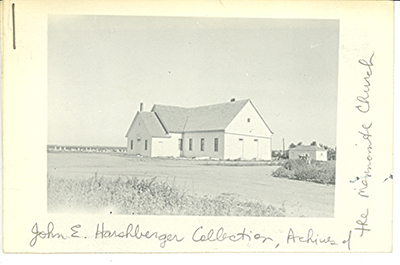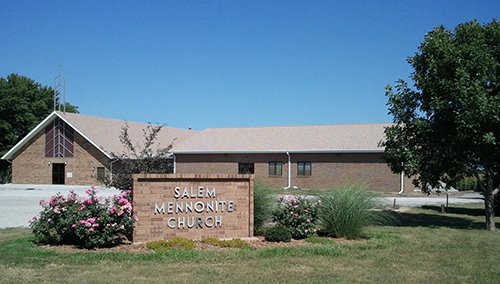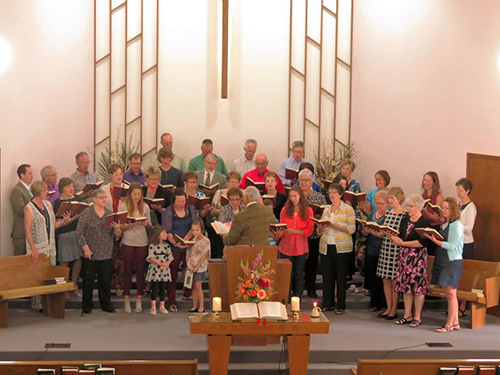 By Kate Lichti
By Kate Lichti
SHICKLEY, Nebraska (Mennonite Church USA) — Salem Mennonite Church celebrated its 125th year this fall with the theme “God’s Faithfulness Throughout All Generations.” The theme prompted long-time member Jan Noel to think about the changes that this rural congregation has seen over the years and to preserve some of its memories through oral history.
Founded by a handful French and German farmers in Shickley in 1891, Salem Mennonite was a member of the Amish Mennonite Conference before joining the Iowa-Nebraska Conference of the Mennonite Church and finally Central Plains Mennonite Conference and Mennonite Church USA.

Salem Mennonite Church, Shickley, Nebraska, circa 1948. Archives of Mennonite Church USA.
With changing affiliation and historical trends, the practices of the church have changed dramatically over time. So much so, Jan says, that, “The younger generation really doesn’t know how services here used to work.”
Jan and Shawn Nolt, Salem’s current pastor, decided to interview the church’s most senior members in an effort to preserve memories of the church from the Depression era onward.
As a retired geriatric nurse, Jan was well suited to the task. “You can learn a lot from older people,” Jan says, adding that she has always loved listening to their stories.
Pastor Shawn adds: “We also encouraged people to share for the benefit of those members who didn’t grow up in our congregation. The hope is that our past will continue to influence our identity and ongoing work in the community.”
Jan and Pastor Shawn organized four small-group sessions of two to eight people, ages 80 to 96. With video camera in hand, they gathered around tables to chat over cups of coffee. They met in homes, at the church and at a local nursing home. Jan came prepared with prompts to get conversation going: “What are your earliest memories of church? What was pastoral leadership like? Do you remember church rituals like weddings, funerals and communion? Service projects and social life?” Throughout the conversations, interviewees considered what has changed and what has stayed the same at Salem.

Salem Mennonite Church today. Photo provided.
The changes were many. Every interview group was full of stories about rules that have since changed: women wearing head coverings, no musical instruments allowed in the sanctuary, no wedding rings and a hesitancy to allow Christmas pageants or choristers at the front of the sanctuary due to concerns about pridefulness.
“There was a lot of emphasis on the verse Romans 12:2, ‘Be not conformed to this world,’ ” Jan says.
Jan learned from interviewing the older generation that, “Part of the difference between my experience and their experience was that many of them were more strictly involved with Mennonites, whereas I was involved with the public school where not everybody was acting in the same way.” As young people began to move from country schools to the high school, where activities like band and sports became popular, Mennonites had to reassess how much their children could participate.
Over time, Salem began to loosen many of its practices. While none of the interviewees pinpointed the changes to a particular time or decision, many noted the building of the new church in 1967 as an important turning point. One interviewee, Dan Swartzendruber, remembered the first Sunday they used the new church building.
“(In the old church) the women sat on one side and the men on the other,” he said. “(That day) we all walked out the front door, and we met with our wives and families,” he remembers. “We walked into the new church hand-in-hand with our families and sat together.”
Jan noticed that it was difficult for people to answer the question of what specific teachings they remembered from sermons. Instead, watching the interviews, one gets the impression that the memories that last are of relationships and people in the tight-knit community. Love and service in action, rather than in words, form the heart of the community’s identity.
Interviewee Madonna Swartzendruber remembers the variety of service projects that women undertook, even during lean times: sewing, cleaning houses, preparing food for a children’s home in Kansas City. She remembers that when tragedy struck any farm family, Mennonite or not, all the neighbors would join together to help with planting, harvesting or rebuilding.
For Jan, one of the most moving moments of the interviews was when one man remembered his baptism and the experience of having the bishop wash his feet after he took communion for the first time. “(This man’s) memory is slipping a bit,” says Jan. “We weren’t sure he’d be able to participate, but he remembered that instance very vividly.”

An impromptu choir sings at Salem’s 125th anniversary celebration, led by John Lauber. While worship now includes musical instruments, the congregation still has a strong tie to a capella singing. Photo by Lisa Hendrickson.
These days, Salem is more focused than ever on extending those relationships of love and service into the broader community. Over the years, churches in the small town have opened their doors to worship together. During Lent, four churches—Methodist, Catholic, Church of the Brethren and Mennonite—take turns hosting weekly Wednesday night services, with ministers from each church trading pulpits. Several interviewees saw these services as a positive trend.
With a membership of 181 in a town of about 350 people, the church has an opportunity to have a big impact. Jan notes that Salem’s weekly community dinner and children’s program is attended by folks from around the community. Salem’s summer Vacation Bible School serves children from within and outside the church.
Pastor Shawn reflects: “If you look at us in our local community, you can’t tell any longer who we are by what we wear. So we have the question: How do we still identify as Mennonites?” He sees the congregation living out some important tensions in discerning that identity: the tension between honoring strong family ties while also welcoming many new members from diverse denominational backgrounds; the tension of living faithfully without standing in judgement of others; the tension of remaining separate from the world and engaging in the world.
“One of the important aspects of the Anabaptist faith is that we believe Christ’s kingdom is here, now,” Pastor Shawn says. “Our faith influences what we do right now, how we live and work. And we value being together and working together over agreeing.”
That much remains constant.
# # #

